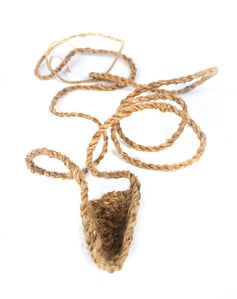Presented by Museum of the Peace Corps Experience and American University Museum
c. 1979
Lower River Division, The Gambia
Grass, dimensions variable
Collection, Museum of the Peace Corps Experience
Gift of Paul Jurmo, The Gambia, Pakalinding 1976–79

When I first saw the slings, I thought of David and Goliath. Young boys, probably 7 to 12 years old, would go out into the field, sit under a tree, and keep the weaver birds from eating the millet crop by flinging pebbles at them with handwoven grass slings.
Protecting the crops was one of the jobs given to boys—an example of the gender- and age-related responsibilities expected of Gambian community members. In this case, growing crops in a fragile Sahelian environment required a tremendous amount of work and significant financial investment. If weaver birds, beautiful though they might be, eat much of the crop when you’re not looking, families have wasted their investment and lost an important source of food and income. The boys and their slings thus had an important role to play in crop protection.
I told the boys that I thought the slings were cool, and they showed me how to use them—although I attained nowhere near their skill level. Intrigued, I asked if I could get one of them to show my family in America. A few days later, the boys returned with a new sling made just for me.
The Committee for a Museum of the Peace Corps Experience is a 501(c)(3) private nonprofit organization. Tax ID: EIN # 93-1289853
The Museum is not affiliated with the U.S. Peace Corps and not acting on behalf of the U.S. Peace Corps.
Museum of the Peace Corps Experience © 2024. All Rights Reserved.